Prince George's County Fire/EMS Department
The Prince George's County Fire/EMS Department (PGFD) is a combination career/volunteer county-level agency that provides "..fire prevention, fire protection, emergency medical services, rescue services and community outreach programs" for residents of Prince George's County, Maryland.[2] The department is composed of volunteers from 33 fire companies throughout the county, that are represented by the Prince George's County Volunteer Fire & Rescue Association, as well as career firefighters affiliated with the Prince George's County Professional Firefighters and Paramedics Association[3], IAFF Local 1619. According to the Firehouse Magazine 2010 Combination Fire Department Run Survey, the Prince George's County Fire/EMS Department covers a response area of approximately 580 miles, protects approximately 900,000 people, and has an annual operating budget of $132 million. Prince Georges County Fire/EMS Department responded to 148,506 calls in 2016 according to the 2016 National Run Survey[4]. 29,702 of those calls were fire related and 118,804 that were EMS calls, making Prince Georges County Fire/EMS Department the busiest combination fire department in the United States to submit statistics.
- Not to be confused with Prince George County Fire Department (Virginia)
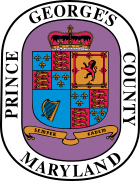 | |
| Semper Eadem (English: "Ever the Same") | |
| Operational area | |
|---|---|
| Country | |
| State | |
| County | |
| Agency overview | |
| Established | 1966 (historically 1742) |
| Employees | 1,100 volunteer personnel 720 career personnel 80 support personnel[1] |
| Staffing | Combination (professional and volunteer) |
| Fire chief | Tiffany D. Green |
| EMS level | 38 BLS, 16 ALS |
| Facilities and equipment | |
| Stations | 48 Stations Organized into 7 Battalions |
| Engines | 71 |
| Trucks | 22 |
| Squads | 11 |
| Ambulances | 54 |
| Fireboats | 3 |
History
In 1742, the town of Bladensburg became the first governmental entity to pass a fire prevention ordinance. The simple ordinance stipulated that all residential and commercial buildings had to be equipped with a smoke chimney. In 1886, the town of Hyattsville organized the first volunteer fire company in the county. With a donated budget of $27, the fire company bought a two-wheeled hand truck equipped with a barrel, pump, and hose. Two years later, in 1888, the town of Upper Marlboro organized the Marlboro Fire Association following two major town fires. John C. Wyvill had the first fire station built at a cost of $342.
It wasn't until the 1930s that the County organized its fire services at is known today. The University of Maryland created a Fire Service Extension to train firefighters and is widely regarded as a focal point for fire training for departments located east of the Mississippi River.
In 1966 the county incorporated paid firefighters within its volunteer force based on the Yarger Study which stated:
- At least two "paidmen" at each station.
- All paid firefighters should be county employees.
- A unified command structure should be developed under the direction of a County fire chief.
- Fire communications should be consolidated under the County fire chief.
The Department of Fire Protection was created on June 14, 1968 which consumed all other previous fire organizations under a single command.[5]
In May 2009, the PGFD received local media attention following a massive natural gas explosion at a Forestville stripmall. PGFD Captain Robert Rouse (Engine 823) was one of 8 firefighters and 1 gas worker injured during the event.[6][7]
List of fire chiefs
- Lawrence R. Woltz
- Frank Briguglio
- M.H. (Jim) Estep
- Steven T. Edwards
- Lemuel A. Roberts
- AD. Bell, Sr.
- Ronald J. Siarnicki
- Ronald D. Blackwell
- Lawrence H. Sedgwick, Jr.
- Eugene A. Jones
- Marc S. Bashoor
- Benjamin Barksdale
Organization
The Prince George's County Fire/EMS Department is composed of 4 distinct commands, Emergency Operations, Administrative Services,Support Services, and Volunteer Services. Each of the commands are headed by a Deputy Fire Chief (formerly known as Lieutenant Colonel) who reports directly to the Fire Chief.[8]
Operations
The Emergency Operations Command (EOC) is the largest and most visible resource to the public. The EOC includes daily operations and of all emergency services, both Fire and EMS. The EOC incorporates both sworn career and volunteer Firefighter/EMT's. The EOC is further split into Northern and Southern Divisions. The dividing line between North and South within the fire department is Pennsylvania Avenue or Maryland Route 4. Within each division there are a set of battalions. Battalions 1,2,4,and 6 are located in the Northern Division and Battalions 3,5,and 7 are located within the Southern Division. "The PGFD's busiest service areas are located within Battalions 1,3,and 5 which includes the area commonly bordered by the District line to the west, Central Avenue to the north, the Capitol Beltway to the east, and Allentown Road to the South. These areas represent better than 60% of the PGFD's total calls for service, as they contain the highest population densities."[8]
Battalions
The Prince George's County Fire/Emergency Medical Services Department is organized into seven battalions. A breakdown of the battalions along with their communities and stations within the county is as follows:
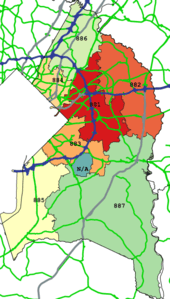
- Battalion 881: Battalion 881 serves the communities of Landover, Largo, New Carrollton, and Lanham. It includes stations 6, 28, 30, 33, 37, 38, 46, and 48.
- Battalion 882: Battalion 882 serves the communities of, Bowie,and Glenn Dale. It includes stations 16, 18, 19, 39, and 43.
- Battalion 883: Battalion 883 serves the communities of District Heights, Morningside, Hillcrest Heights, Suitland, Forestville, Seat Pleasant, and Capitol Heights. It includes stations 5, 8, 17, 23, 26, 27, and 29.
- Battalion 884: Battalion 884 serves the communities of Langley Park, Chillum, Mount Rainier, College Park, Bladensburg, and Riverdale. It includes stations 1, 7, 9, 12, 13, 34, 44, and 55.
- Battalion 885: Battalion 885 serves the communities of Accokeek, Camp Springs,and Oxon Hill. It includes stations 21, 24, 32, 42, 47, and 58.
- Battalion 886: Battalion 886 serves the communities of Laurel, Greenbelt, Beltsville,and Berwyn Heights. It includes stations 10, 11, 14, 31, 35, 41, and 49.
- Battalion 887: Battalion 887 serves the communities of Upper Marlboro, Clinton,and Brandywine. It includes stations 20, 25, 36, 40, and 45.
The Administrative Services command includes Human Resources, Logistics and Supply, Fiscal Affairs, Facilities and Resource Planning, and Apparatus Maintenance. The Administrative services command incorporates both sworn career firefighters and career civilian employees.
The Special Operations Command includes The Office of the Fire Marshal, Risk Management and Safety, Professional Standards, The Fire/EMS Training Academy, and Technical Services. Technical Services includes, but is not limited to the department's HazMat Team, Bomb Squad, and specialty rescue companies.
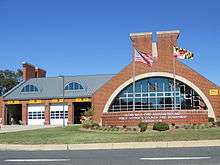 Glenn Dale Station 18 |
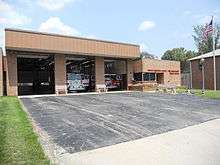 Bowie Station 19 |
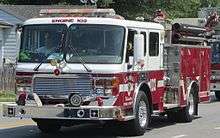 Laurel VFD Engine 103 in 2012. |
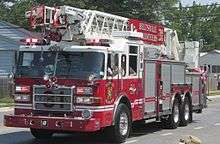 Beltsville VFD Truck 31 |
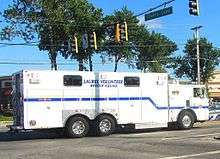 Laurel VRS Squad 49 |
Special designations
Company 15 - Fire Investigators & Bomb Squad
Companies 56/57 - Water Rescue & Recovery Team
Dive Unit, Dive Support Unit, 22' Boston Whaler, (2) 14' Support Boats, 2 Fireboats
Company 62 - Apparatus Maintenance
Company 65 - Fire/EMS Training Academy
Consolidated or disbanded fire stations/companies
Company 2 - Cottage City Volunteer Fire Company
Consolidated into Company 55
Company 3 - Mount Rainier Volunteer Fire Company
Consolidated into Company 55
Company 4 - Brentwood Volunteer Fire Company
Consolidated into Company 55
Company 6 - Hillside Volunteer Fire Department
Disbanded in 1999. This station was located at 1234 Larchmont Avenue in Capitol Heights. When the new station on St. Joseph's Drive in Largo opened it was given 6 as its number designation
Company 22 - Tuxedo-Cheverly Fire Station
Station Closed; Company Number Retired.
Company 53 - Special Operations Division (Haz Mat/Bomb Squad)
Services relocated to other stations/offices.
Equipment
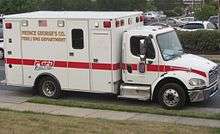
The PGFD is a progressive agency with a full complement of modern fire training, equipment, and vehicles. PGFD predominately uses volunteer owned apparatus, as volunteer agencies within PGFD often purchase their own apparatus. Two-thirds of all suppression apparatus in Prince George's County are volunteer-owned. 69 of 90 engines within the PGFD are owned by volunteer organizations, and 14 of 25 aerial apparatus are owned by volunteers. Ambulance units respond to Basic Life Support calls and are staffed with certified Maryland EMTs. Medic units respond to Advanced Life Support calls such as respiratory problems or cardiac arrest, and are staffed with certified Maryland Paramedics. Engine companies respond to both EMS calls and fire calls. Ladder companies respond to calls involving fires or an odor of gas within a structure. Rescue squads and rescue engines respond to incidents generally described as more life-threatening such as motor vehicle crashes or entrapments. A special service unit(Truck/Tower/Rescue/Rescue Engine) can act as Rapid Intervention Team units on a working fire if needed. The Rapid Intervention Team is normally the 4th due engine combined with the special service apparatus dispatched once a working fire is confirmed.
PGFD issues every Firefighter/EMT a Cairns Metro 660C helmet, but firefighters can purchase their own Cairns Sam Houston Model N6A1, Cairns Classic 1000 and 1010, Cairns 1044, and the Morning Pride Ben 2 Plus Fire Helmet if they choose. Every Firefighter/EMT is also issued a coat, Nomex hood, pants, gloves, rubber boots, and face piece. PGFD uses Scott Safety 5.5 Self Contained Breathing Apparatus for their breathing apparatus, and the Scott AV-3000-HT for their individual firefighter face piece.
Blue Helmet - EMS provider only
Red Helmet - A Firefighter that does not have a Firefighter I certification from MFRI yet; they can do anything except go inside structure fires.
Yellow/Black Helmet - Firefighter/EMT
White helmet w. regular coat - Company officer (Captain, Lieutenant, etc.)
White helmet w. white coat - Chief officer (Chief, Deputy Chief, etc.)
Run Statistics
According to a 2016 Prince George's Fire Department Run Survey[9]
- The Busiest Station was Silver Hill Fire/EMS Station 829
- Station 829 responded to 17,173 calls
- The Busiest Ambulance was Silver Hill Ambulance 829
- Ambulance 829 responded to 5,431 calls
- The Busiest Paramedic Ambulance was Forestville Paramedic Ambulance 823
- Ambulance 823 responded to 3,809 calls
- The Busiest Engine was Paramedic Engine 842
- Engine 842 responded to 3,965 calls
- The Busiest Truck/Tower was Berwyn Heights Truck 814
- Truck 814 responded 1,182 calls
- The Busiest Heavy Duty Rescue Squad was Morningside Rescue Squad 827
- Rescue 827 responded to 1,770 calls
- The Busiest Medic Unit was District Heights Medic 826
- Medic 826 responded to 3,872 calls
- The Busiest Haz-Mat Unit was College Park Hazmat 812
- Hazmat 812 responded to 136 calls
- The Busiest Battalion Chief was Battalion Chief 883
- Chief 883 responded to 1,597 calls
Calls by Station (In order by 2016 Call Volume)[9]
| Station | Calls |
|---|---|
| Silver Hill
829 |
17173 |
| District Heights
826 |
15413 |
| Largo/Kettering
846 |
10446 |
| Landover Hills
830 |
10210 |
| Clinton
825 |
9922 |
| Chillum
844 |
9262 |
| Oxon Hill (Glassmanor)
842 |
8600 |
| Chapel Oaks
838 |
8578 |
| Springdale
806 |
8336 |
| Forestville
823 |
7622 |
| Fort Washington
847 |
7369 |
| Morningside
827 |
7098 |
| Oxon Hill
821 |
6874 |
| Kentland
833 |
6849 |
| College Park
812 |
6822 |
| Bladensburg
809 |
6640 |
| Laurel Rescue
849 |
6591 |
| Glenn Dale
818 |
6573 |
| Chillum-Adelphi
834 |
6496 |
| Laurel Fire
810 |
6455 |
| Hyattsville
801 |
6042 |
| Calverton
841 |
6042 |
| Capitol Heights
805 |
5893 |
| Allentown Road
832 |
5524 |
| Berwyn Heights
814 |
5215 |
| Greenbelt
835 |
5144 |
| Northview
816 |
4943 |
| Beltsville
831 |
4589 |
| Brandywine
840 |
4473 |
| Upper Marlboro
820 |
4426 |
| Bunker Hill
855 |
4083 |
| Pointer Ridge
843 |
3964 |
| Croom
845 |
3748 |
| Branchville
811 |
3501 |
| Ritchie
837 |
3329 |
| Riverdale
807 |
3197 |
| Bowie - RT 450
839 |
3141 |
| W. Lanham Hills
848 |
3085 |
| Bowie Old Town
819 |
3013 |
| Accokeek
824 |
2692 |
| W. Lanham Hills
828 |
2673 |
| Riverdale Heights
813 |
104 |
| Baden
836 |
1048 |
| Boulevard Heights
817 |
977 |
| Seat Pleasant
808 |
793 |
| National Harbor
858 |
311 |
| Special Events
853 |
207 |
Standard response guidelines
Units are dispatched hierarchically according to route-to-incident, unit type, staffing, and a number of other factors associated with Calculated Routing, the system which determines which units will be dispatched to an incident in the following order[10]:
- Engines
- Trucks/Towers
- Rescue Squads
- Engine Tankers
- Rescue Engines
- Mini-pumpers & Brush Trucks
- Tankers
- BLS and ALS transport units
- Battalion Chiefs
- EMS Duty Officers
- Hazardous Materials (HazMat) Units
- Technical Rescue Units
Minimum staffing is also dictated in General Order 03-11[10] which roughly follows National Fire Protection Association standards:
- Engine Company: 3 personnel
- Truck Company: 4 personnel
- Rescue Squad: 4 personnel
- Rescue Engine: 3 or 4 personnel depending on whether the unit is providing service as an engine or a rescue squad
- Engine Tanker: 3 personnel
- BLS ambulance/ALS transport unit: 2 personnel
- Specialty Units: varies
Call Types
- Local Alarms
- Local Alarm (Respond/Proceed): 1 Engine
- Rescue Local: 1 Engine, 1 Rescue Squad/Rescue Engine, 1 Ambulance
- Rescue Local with Entrapment (Upgrade): 1 Engine, 1 Rescue Squad/Rescue Engine, 1 Medic Unit,1 BLS Ambulance, 1 EMS Supervisor, 1 Battalion Chief
- Ambulance Local: 1 Ambulance
- Medical Local: 1 Engine or 1 Ambulance, 1 Medic Unit
- Medical Local (Shooting/Stabbing): 1 Engine, 1 Ambulance, 1 Medic Unit
- Working Code (CPR in progress): 1 Engine, 1 Ambulance, 1 Medic Unit, 1 EMS Supervisor
- Haz-Mat Local: 1 Engine, 1 Haz-Mat Unit
- Street Assignments: 2 Engines, 1 Truck/Tower, 1 Special Service (Tower, Truck, Quint, Rescue Engine or Rescue Squad), 1 Battalion Chief
- Street Assignment (In Non-Hydrated Areas): 2 Engines, 1 Special Service (Truck or Rescue Squad), 1 Tanker, 1 Battalion Chief
- Haz-Mat Street Assignment: 2 Engines, 1 Special Service (Truck or Rescue Squad), 1 Haz-Mat Unit, 1 Ambulance, 1 Medic Unit, 1 EMS Supervisor, 1 Battalion Chief
- Box Alarms: 4 Engines, 2 Trucks, 1 Special Service (Truck or Rescue Squad), 1 Ambulance, 2 Battalion Chiefs
- Box Alarm (In Non-Hydrated Areas): 4 Engines, 2 Trucks, 1 Special Service (Truck or Rescue Squad), 3 Tankers, 1 Water Supply Unit, 1 Ambulance, 2 Battalion Chiefs
- Haz-Mat Box Alarm: 4 Engines, 2 Special Services (Truck or Rescue Squad), 1 Haz-Mat Unit, 1 Ambulance, 1 Medic Unit, 1 EMS Supervisor, 1 Haz-Mat Coordinator, 2 Battalion Chiefs
- Working Fire(Upgrade):1 Engine, 1 Truck, 1 Medic Unit, 1 Safety Officer, 1 Volunteer Safety Officer, 1 EMS Supervisor
- Task Force Alarm(Optional Upgrade): 2 Engines, 1 Special Service (Truck or Rescue Squad)
- 2nd Alarm: 4 Engines, 2 Trucks, 1 Special Service (Truck or Rescue Squad)
- 3rd Alarm: 4 Engines, 2 Trucks, 1 Special Service (Truck or Rescue Squad)
- 4th Alarm: 4 Engines, 2 Trucks, 1 Special Service (Truck or Rescue Squad)
- 5th Alarm: 4 Engines, 2 Trucks, 1 Special Service (Truck or Rescue Squad)
- Airplane/Train Crash: 2 Engines, 1 Rescue Squad, 1 Haz-Mat Unit, 1 Foam Unit, 1 Brush Unit, 1 Ambulance, 1 Medic Unit, 1 EMS Supervisor, 2 Battalion Chiefs
A Street Assignment is an odor of natural gas inside of structure, investigation of something burning inside of structure, electrical socket sparking, chimney fire, and other similar things.
A Box Alarm is the report of smoke or fire in ANY structure, such as a house, building, apartment, condo, townhouse, or school.
References
- "Archived copy". Archived from the original on 2009-03-27. Retrieved 2008-12-17.CS1 maint: archived copy as title (link)
- http://www.co.pg.md.us/Government/PublicSafety/Fire-EMS/index.asp?nivel=foldmenu(1)
- http://www.pgcvfra.org/
- Roche, Kevin (July 2017). "2016 National Run Survey Part 2" (PDF). Firehouse Magazine.
- "Archived copy" (PDF). Archived from the original (PDF) on 2009-06-17. Retrieved 2008-12-17.CS1 maint: archived copy as title (link)
- http://www.gazette.net/stories/05082009/prinnew174942_32546.shtml
- "Archived copy". Archived from the original on 2009-05-10. Retrieved 2009-05-12.CS1 maint: archived copy as title (link)
- "Archived copy". Archived from the original on 2011-12-11. Retrieved 2011-11-28.CS1 maint: archived copy as title (link)
- Pgfd (2017-02-21). "Prince George's County Fire/EMS Department: PGFD 2016 Run Statistics". Prince George's County Fire/EMS Department. Retrieved 2018-05-07.
- Prince George's County Fire/EMS Department; Marc S. Bashoor (15 January 2016). "Standard Response Dispatch Procedure". Standard Response Dispatch Procedure (PDF) (General Order 03-11 ed.). Communication and Information Management/Technology Division. Retrieved 14 December 2019.